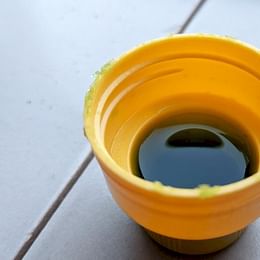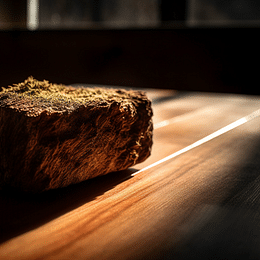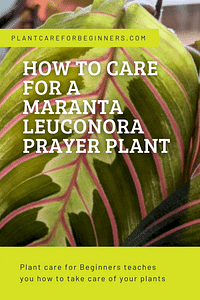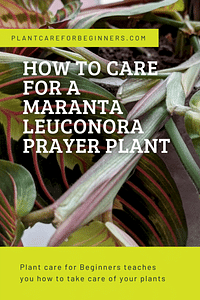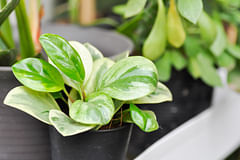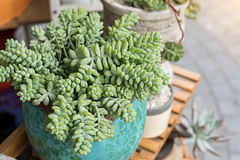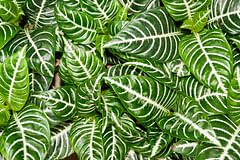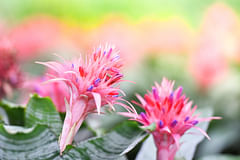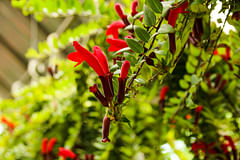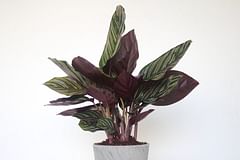How to care for a Maranta Leuconora (Prayer plant)
The Maranta Leuconora, also known as the Prayer plant, is a tropical plant that's closely related to a Calathea. In this plant care guide, we're going to look at how you can best take care of this beautiful, yet easy to care for houseplant.
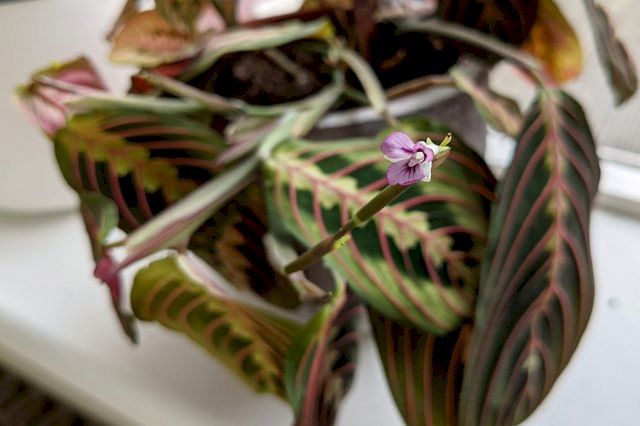
The Maranta Leuconora, also known as the Prayer plant looks a lot like a Calathea, but isn't a Calathea. Calathea's are notoriously difficult plants to take care of, but the Maranta Prayer Plant on the other hand is quite easy to care for. The Maranta gets its nickname, Prayer plant, from the fact that it closes its leaves during the night.
The Maranta is a great alternative for a Calathea when you think a Calathea is too tough to take care of (we've all been there). It's not a very demanding plant and is great for those of you who like to water your plants every week. It's not the best houseplant for beginners, because it doesn't show you what it needs through clear signs. It's not a difficult plant to care for, but it requires a little practice.
In this plant care guide, we're going to explore these topics:
Let's dive right in and find out how to take care of this beautiful tropical plant!
Watering your Maranta
The Maranta Leuconora is a thirsty plant and loves to be in moist soil. It's a thirsty plant because it's a trailing plant, much like a Philodendron and a Pothos. Your Maranta can grow longer vines with beautiful leaves. These vines mean that the roots of your Maranta have to work hard if the vines are long. There is a lot of plant to water after all.
When you have a thirsty plant, like the Maranta, you should water it once per week. The Maranta can be quick to absorb the moisture so the soil might dry out before the week is over. It might be tempting to water your plant before that time, but it's better to wait until the week is over.
By letting the soil (almost) dry out, you avoid accidentally overwatering your plant. Another benefit of letting the soil (almost) dry out is that oxygen can more easily reach the roots of your Prayer plant. Getting oxygen to the Maranta's roots also helps to prevent root rot. If you notice that the soil dries out after a day or two, you might have to consider changing the soil or see if your plant needs to be repotted. More about this later.
Sunlight exposure
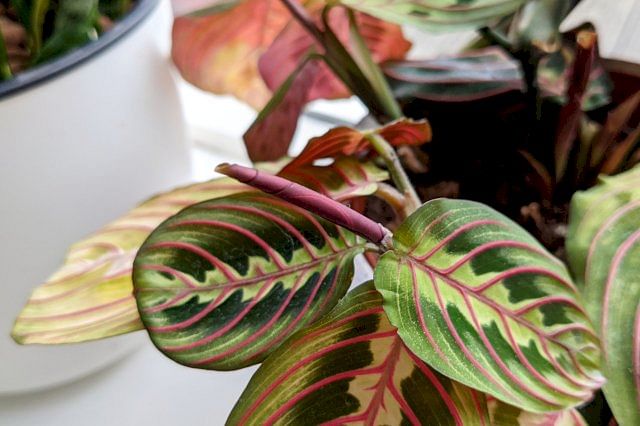
A Maranta Leuconora grows in the jungle at ground level, where it's humid, warm, and shaded. Its natural habitat gives us a clue as to what kind of sunlight exposure this plant thrives in. Like its cousin, the Calathea, the Maranta does best in bright indirect sunlight.
You can also put this wonderful plant in a spot that has less bright sunlight, but not low light. The Prayer plant thrives in this bright indirect sunlight, but can't survive in direct sunlight. Direct sunlight will burn its leaves and unfortunately make a permanent burn mark.
Yellow leaves
If you notice that your Maranta's leaves are turning yellow, it could mean two things. It could be that your Maranta is getting too much sunlight and you should move it to a darker location. It could also mean that the leaf is just an older leaf and it's turning yellow because of its age.
Temperature requirements
The Maranta comes from the warm and humid tropics, so it's no surprise that this plant loves warmth. This plant is native to the tropical forests of Brazil, so it enjoys higher temperatures the higher humidity as well. This plant doesn't do well in cold air but it shouldn't be too hot either.
Ideally, you should keep your Prayer plant at a temperature between 18 and 27 degrees Celsius (65 to 80 F). It's also important to keep in mind to prevent sudden temperature changes or extremes, as this can stress the plant and cause its leaves to curl or droop.
Things like cold/hot drafts from open windows, air conditioning units, and heating vents can cause these sudden temperature changes. Keep your Maranta plant away from these for a stable growing environment.
If the temperature drops below 18 degrees Celsius (65 F), consider moving the plant to a warmer spot. On the other hand, if the temperature rises above 27 degrees Celsius (80 F), it's a good idea to move the plant to a slightly darker spot.
Humidity ranges for your Maranta
In the previous section, we found out that the Maranta grows in the rainforests of South America, so it loves higher levels of humidity. To keep your Prayer plant healthy and happy, it's important to maintain a humidity range of 50-60%.
But don't worry, you don't need to invest in a fancy humidifier to achieve this ideal range! There are several simple tips and tricks you can use to increase humidity levels around your plant. For example, you can place a tray of water near your plant, mist the leaves regularly with a spray bottle, or even group your plants to let them create a microclimate of moisture.
It's important to note that if humidity levels drop below 40%, your Prayer plant may experience dry leaf tips and wilting. On the other hand, if humidity levels exceed 70%, your plant may be susceptible to fungal and bacterial diseases. So, maintaining a consistent humidity level within the ideal range is key.
Soil for a Prayer plant
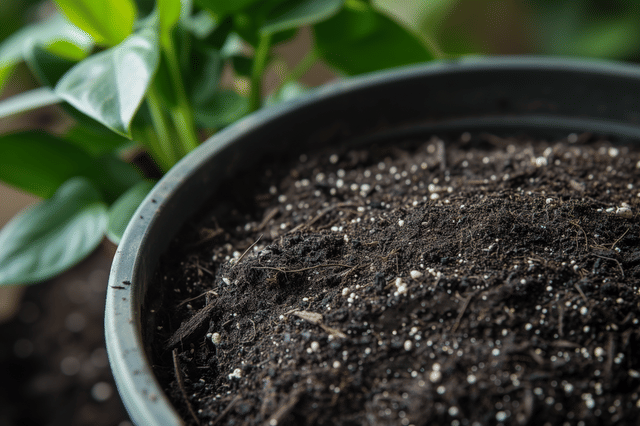
The Maranta Prayer plant loves to be in moist soil as we discovered earlier on in this plant care guide. Now that we know that, we can pick some ingredients to improve normal potting soil. When you water soil often, it tends to compact and thicken. We need to avoid this because this prevents oxygen from reaching your plant's roots. However, we can't add things like perlite to your potting soil without adding extra ingredients, because this would drain the moisture away too quickly.
So how can we make the perfect soil for this plant? Peat moss! Peat moss is dead and decayed Sphagnum moss and it's great at retaining moisture while keeping the soil light. This combination will make sure enough moisture stays in the soil, but your plant's roots also get enough oxygen. It helps your plant stay moist, but also reduces the risk of getting root rot.
Fertilizing your Maranta
Earlier on, we discovered that the Maranta is a thirsty plant because it grows quite quickly and can have long vines. Quickly growing plants like this need a bit of fertilizer during their growing season. The growing season of the Maranta is the entire spring and summer. During the fall and winter, your Prayer plant won't grow as much anymore. However, it often won't stop growing all the way, it'll just be slower.
You can help your Maranta grow properly by fertilizing it once per month during the spring and summer. There are many ways to fertilize your Prayer plant, but the easiest might be to use a liquid fertilizer. This is the easiest way to fertilize your Maranta because it needs to be watered weekly anyway.
When using any fertilizer, make sure to follow the directions on the label. This will help you to feed your plant enough: not too much or too little.
If you want to find more ways to fertilize your plants, have a look at "What is the best type of fertilizer for houseplants?".
Seasonal care for your Maranta
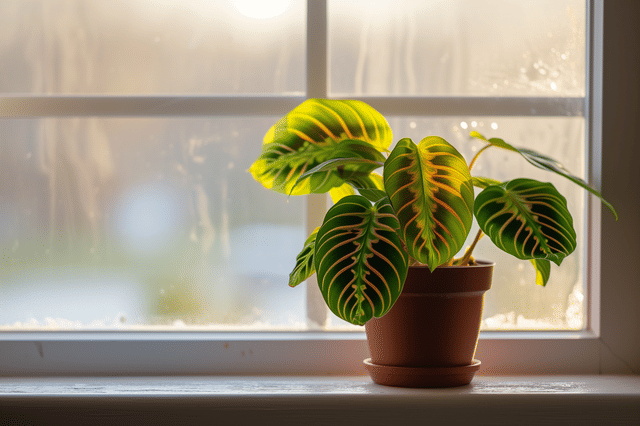
As a Maranta owner, it's important to understand that the different seasons have a big impact on how you take care of your plant.
Spring and summer
During summer, this tropical plant needs more moisture, humidity, and sunlight. The warm weather helps the growth of new leaves, and you might notice your plant becoming more active. The warm weather will also dry out the soil more quickly, so you'll need to water your Maranta more often during summer to make sure it stays lush and healthy. Make sure to check the soil before you water it to prevent overwatering.
The humidity levels during summer can drop, and this can cause the leaves of your Prayer plant to dry out and turn brown. To prevent this, you can place a pebble tray underneath your plant to increase the humidity levels. You can also mist the plant occasionally.
Prayer plants enjoy bright but indirect light during summer, so make sure that it's not exposed to direct sunlight to avoid leaf burn.
Fall and winter
When it's winter, things change a bit with lower temperatures and light levels. During this time, your Maranta will slow down its growth and might become dormant. You'll need to water your plant less often to prevent overwatering your plant. The plant won't absorb as much moisture and it won't be evaporated as quickly. Overwatering during winter can lead to root rot and ultimately kill your plant.
The air in our houses during winter can become drier, and this can leave your Prayer plant struggling to cope. Like in the summer, you can use a humidifier or a pebble tray to increase the humidity. Keep your plant away from direct cold drafts as it can cause stress and shock.
Pruning and trimming your Prayer plant
Pruning is a very important part of keeping any plant healthy in the long term. Pruning helps to prevent issues and can lead to bushier growth. Here's how and when to prune your Maranta Leuconora.
The best time of year to prune your Maranta is in the spring or summer when the plant is actively growing. You'll need a sharp pair of shears or scissors that are clean and disinfected to prevent the spread of disease between multiple plants.
To start, find any dead or damaged leaves. You should remove these to prevent the spread of disease and encourage new growth. Cut them as close to the base of their stem as possible and be sure to make a clean cut to avoid damaging the remaining healthy part of the plant.
Once the dead and damaged leaves are gone, you can remove leggy growth. Cut back to just above a leaf node to encourage new growth from that node.
Last but not least, to promote bushier growth, consider pinching the tips of new growth. This will encourage the plant to produce lateral branches and become more full-bodied.
After a while, you might notice your plant seems to slow down its growth, even in the spring and summer. If that happens it might be time to repot your plant. Let's look at that a little closer!
Repotting your Maranta
It is a good idea to repot a Maranta prayer plant when it becomes root-bound, which means the roots have outgrown the pot. When you notice that the plant is no longer growing or blooming, it is likely time for a bigger pot.
You can repot your Maranta at any time of year, but I recommend you stick to only repotting your plants in the spring or early summer to give them the best chance to settle into their new growing environment without getting too stressed.
First, choose a pot that is slightly bigger than the one your Maranta is currently in, as this will provide it with more space for root growth. Make sure the pot has drainage holes in the bottom, to prevent root rot and waterlogging. Add some fresh potting soil to the base of the pot.
Gently remove the plant from the old pot and place it in the new pot. Fill in any gaps with more fresh potting soil, softly pressing down on the soil to remove air pockets. Be careful not to pack it too tightly. After repotting, water your Maranta thoroughly and place it in a bright, indirect light location.
Now you've successfully repotted your plant and you won't have to repot it again for 1-2 years.
Propagating your Maranta
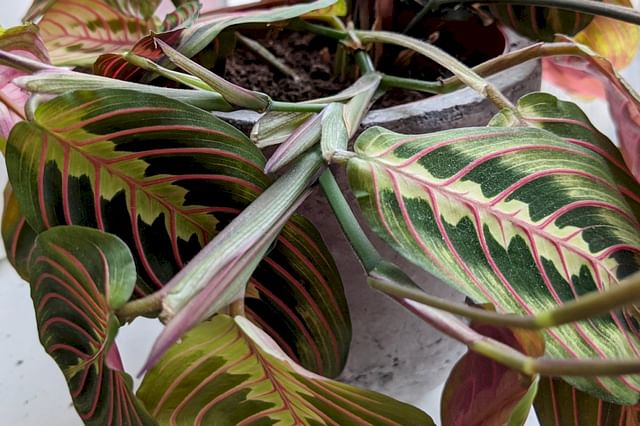
A lot of trailing plants are easy to propagate because they start to grow air roots by themselves. The Maranta is no different. In the picture above, you can see new parts of stems come out of the old part of the stems.
When you want to propagate a Maranta, you can simply cut off part of the stem and propagate it in a jar with water. In a few short weeks, your Maranta cutting should have grown longer roots. You can then replant it in a new pot with fresh potting soil or Leca, and you'll have successfully propagated the Prayer plant.
Propagating your Maranta is a great way to create more plants without having to spend money on more Prayer plants.
Air circulation for your Prayer plant
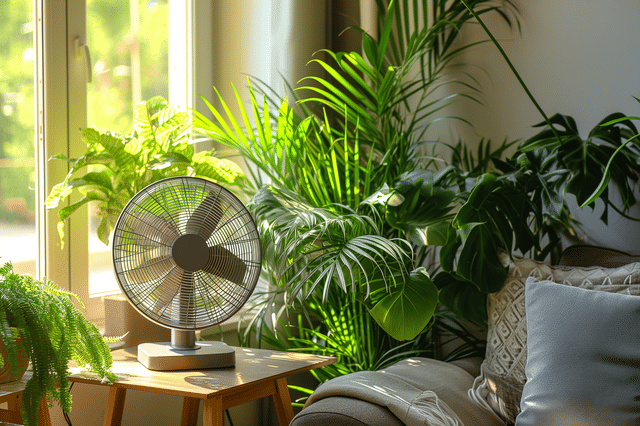
If you're new to taking care of plants, you may not know how important air circulation is for the health of your plants. Good airflow is critical for the overall health of your plant, and it can help prevent and treat pest infestations too. In this section, we'll look at a few essential tips to create a well-ventilated environment for your Prayer plant.
A room with windows
Maranta plants thrive in bright, indirect light and need a room with proper ventilation. To give it this ideal space, avoid placing your Prayer plant in a room with no windows or airflow, like a basement or closet.
Desk fans
If the windows can't open in a specific room, you can also use a small desk fan. Running a fan near your plant can be a great way to create airflow that will keep the leaves of your plant moving and slowly dry out the leaves and top of the soil. This can help to prevent some pests.
Air circulation is important, but make sure to not place your Maranta Prayer plant near heating vents or air conditioning units. These devices do create great airflow but also create sudden temperature changes, which your plant is very sensitive to. If you have to use a device, rather than opening a window, a desk fan is the way to go.
Toxicity
If you have small children or pets, you're in luck: the Maranta Leuconora is non-toxic. Most tropical plants from the jungle are toxic, but luckily this plant is an exception. It might still be a good idea to keep your Maranta away from your pets, in case they like to chew on your plants.
If your pets chew on this plant, your plant will start to leak moisture from its stems. Since your Maranta is a thirsty plant, this leaking won't stop very quickly and take a long time to heal. By putting your plant where your children and/or pets can't reach it, you'll be protecting your plant.
Common pests
Some plants are great at keeping pests away, but the Maranta prayer plant is not one of them. The most common pests that can affect your Maranta include spider mites, scale insects, mealybugs, and whiteflies. Let's look at ways to prevent and treat these pests to keep your plant happy and healthy.
Preventing pest infestations
You might have heard that prevention is better than cure. The same goes for pests on houseplants. There are a few great and easy ways to prevent pests from getting to your houseplants, so you don't have to try to save your plant at all:
- Keep your plant clean by wiping the leaves regularly with a damp cloth.
- Keep your plant healthy. A healthy plant is much less likely to be attacked by pests.
- Regularly inspect your plant to catch any pests early and prevent an infestation.
These 3 tips will help you to prevent most pests from getting to your plants in the first place. But what if you were too late and pests have already gotten to your plant? Let's get rid of them!
Treating pest infestations
If you notice pests on your Maranta, it is important to act quickly to prevent the infestation from getting worse. Here are a few ways to treat pest infestations:
- For spider mites: Spider mites are tiny pests that can cause damage to the leaves of your Maranta. To get rid of spider mites, spray your plant with a mixture of water and soap, or use neem oil spray. Repeat the treatment every few days until the spider mites are gone.
- For scale insects: Scale insects are small, oval pests that can attach themselves to the leaves and stems of your Maranta. To get rid of scale insects, use a cotton swab dipped in rubbing alcohol to wipe them off the plant. Repeat the treatment every few days until the scale insects are gone.
- For mealybugs: Mealybugs are small, white pests that can damage your Maranta's leaves and stems. To get rid of mealybugs, wipe the affected areas with a cotton swab dipped in rubbing alcohol or a mixture of water and soap. Repeat the treatment every few days until the mealybugs are gone.
- For whiteflies: Whiteflies are small, white insects that can fly around your Maranta and cause damage to its leaves. To get rid of whiteflies, spray your plant with insecticidal soap or neem oil spray. Repeat the treatment every few days until the whiteflies are gone.
Remember to always follow the instructions on the label of the product you are using for the best results. By keeping your plant clean and in good health, and by regularly inspecting it for pests, you can enjoy your Prayer plants for years to come.
Common problems on your Maranta Prayer plant
When taking care of a Maranta, you might notice a few signs of trouble on your plant. If you've checked for pests and found nothing, it can be a mystery what your plant might be dealing with, so let's look at a few common signs of trouble.
Leaf curling
If you're noticing curling leaves on your Prayer plant, don't panic! Leaf curling can have a few different reasons and is often quite easy to fix.
One possible cause of leaf curling is dry air. Prayer plants love higher levels of humidity, so if the air is too dry, the leaves could curl up to preserve moisture. To fix this issue, try misting your plant regularly or placing it near a humidifier to increase the humidity levels.
Another reason for curled leaves is overwatering. If the soil is wet (not lightly moist), it can cause the roots to rot and lead to curling leaves. Be sure to check the soil before watering to prevent this from happening.
And the last cause can be pests and diseases. Check your plant regularly for signs of pest infestation, which include small webs, bumps, or cotton-like clusters on the leaves. If you don't find those signs, but the leaves are starting to turn yellow, your plant could suffer from bacterial or fungal infections. Be sure to prune any infected leaves to prevent spreading.
Brown leaves on your Prayer plant
If the leaves of your Maranta are starting to become brown and crispy, it could be due to too much or too little water. If you never let the soil dry out, you might be overwatering your Maranta. If the soil of your Prayer plant dries out in 1 to 3 days, you might be underwatering your plant.
Another reason could be that your plant is getting too much sunlight exposure. If your Maranta is getting too much (direct) sunlight, it will become too warm and dry out (burn marks). An easy fix is to move your plant to a darker spot. Be sure to trim the crispy leaves to prevent any pest infestations.
If you're sure it's none of those causes, the growing environment might be too dry for your Maranta. Dry as in very low humidity. The Prayer plant is a tropical plant that needs a lot of humidity. There are a few great ways to raise the humidity of your plant, which you can read more about at "10 ways to raise the humidity in your house".
Drooping leaves on your Maranta
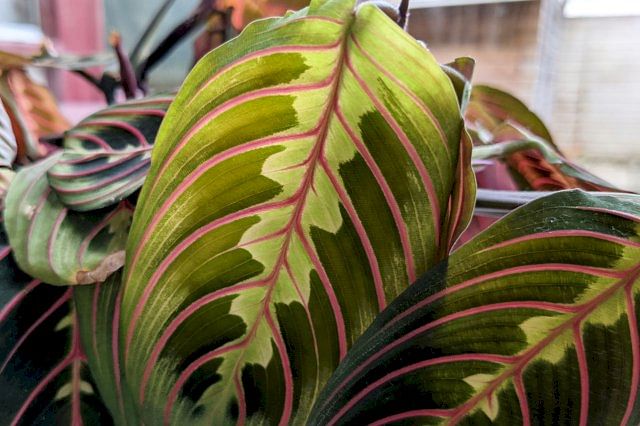
Drooping leaves on your Prayer plant could be one of two things: your plant is too dry, or its stems are heavy. If the soil is dry and your Prayer plant is drooping, water it and see your plant turn back to its normal self. If the stems on your Maranta are quite long, it could just be that the stems and leaves are too heavy to grow upwards.
If you look at pictures of a Maranta on the internet, you might notice how they're often growing upwards. Your own Maranta might grow horizontally, like mine. There is nothing wrong with this, it's natural. The Prayer plant is trailing and has heavy stems and leaves. This weight means that your plant grows horizontally.
If you want it to grow upwards, you'll have to propagate your plant more often, to keep the stems from becoming too long. Just know there is nothing wrong with your plant and it naturally grows horizontally.
Conclusion
The Maranta Leuconora, also known as the Prayer plant, is a tropical plant that's closely related to Calathea. Unlike the notoriously difficult Calathea, the Maranta is quite easy to take care of. A consistent watering routine - once a week and never in dry soil for long - is important to the success of this plant, particularly during the warmer months when its growth is most active. It needs bright, indirect sunlight and a place away from harsh, direct sun.
Pet owners can celebrate the Maranta's pet-friendly nature, making it a worry-free choice for homes shared with furry friends. Pests may occasionally invade, but regular cleanliness, inspection, and quick, effective treatment can keep them away. With these simple Prayer plant care tips in hand, you can nurture your Maranta, making sure it's healthy and vibrant while enjoying the tropical appeal it brings to your home.
Thank you for reading this post! I hope it helps you to keep your plants healthy and beautiful! If you're looking for more guides on specific plants, you can always request a plant guide to get a guide for the plant you have trouble with.
Test your plant care knowledge
Quiz completed!
Want to learn more? Sign up for my newsletter to receive free tips in your inbox!
Sign up now!